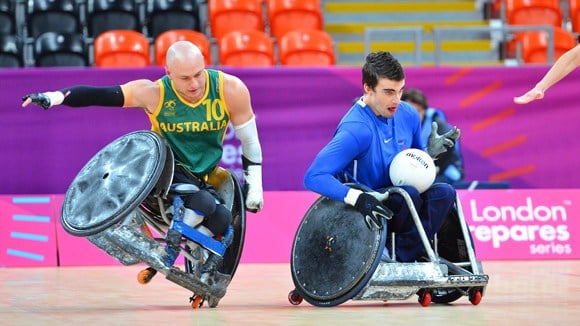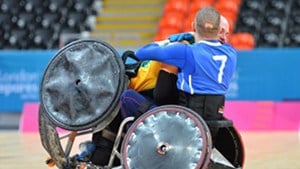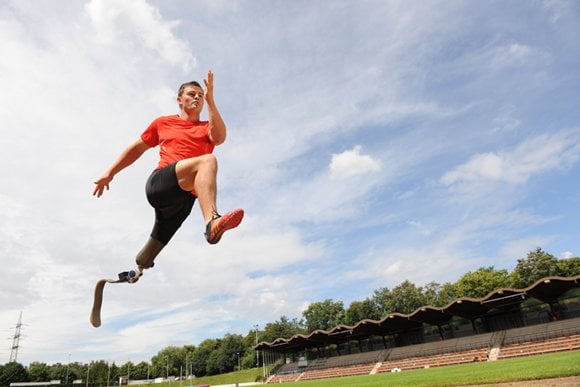Original URL: https://www.theregister.com/2012/07/13/paralympics_prosthetics_makers/
Oiling the big wheels that keep the Paralympics moving
Bladerunner techs and wheelchair wizards gear up
Posted in Science, 13th July 2012 11:42 GMT
The Olympic Games: just saying it conjures up images of top athletes straining for the finishing line, the crowd roaring during the 100 metres final, the heartbreak of a relay team dropping their baton, the sudden spurt in public expertise on sports such as shooting or three-day eventing as the medal tally highlights their national importance.

Great Britain plays Australia at the London Invitational Wheelchair Rugby Tournament, a test event for the London 2012 Paralympics. (GB beat Australia 52 - 51 in extra time). Pic credit: London 2012
All the focus is on the athletes, the competition and the medals. That is what the Games are about. But to get an event of this scale up and running takes dedication and commitment from a lot of people who won’t be wearing Lycra on the day.
Same difference
Consider, for example, the Paralympics – arguably an unsung hero in itself compared with its bigger Olympic brother.
Think of the complex system of classification that allows people with different abilities to compete fairly, or the astonishing achievements of those running or swimming without limbs, playing football without 100 per cent vision or competing in marathons with no legs at all.
Equally remarkable are the people who make and maintain the equipment these athletes need to keep them moving – who make sure the prosthetic limbs fit so well that the wearer can overturn world records and that the wheels on the chairs don’t come off on the last corner.
In London this summer, Ottobock Health Care, a manufacturer of specialist sporting equipment, takes on the responsibility of providing free servicing for all the specialised wheelchairs, artificial limbs and other equipment of the roughly 4,200 athletes who will compete in London after the main summer games are over.
The company will send a total of 13.7 tonnes of equipment to London before the launch of the London 2012 Paralympic Games from their head office in Germany. The first nine tonnes (roughly 15,000 spare parts) have already arrived.
That is a lot of kit.
The company is sending 80 technicians from all over the world to the games. It plans to set up a central servicing centre in the Olympic village and provide teams to all of the nine major venues.
Ken Hurst, manager at the Ottobock Academy UK and technical director Paralympic Games 2012, says that out of the 80-strong technical team, 12 will be welders. As Hurst remarks, some of the athletes are very hard on their equipment.
“We will spend a lot of time repairing chairs. There will be lots of punctures. Once things like the rugby get started, there will also be a lot of welding. They are quite rough on the chairs and there are often lots of little cracks that need fixing,” he says.
Heavy metal

The chairs are built for action as they really take a battering.
Pic credit: London 2012
The chairs designed for rugby look a little like tanks. The wheels seem to have armour plating over their spokes, and the chairs for attacking players have solid bars all around the front, reinforcing the frame.
But despite its bulky appearance, a rugby chair is lighter than an everyday wheelchair.
“The main thing for a sports chair is that it has to be ultra-light as well as extremely strong and durable,” says Simon Tempest, mobility solutions manager at Ottobock.
“It is all about turbo-charging the everyday chair. A sports chair is lower to the ground for a lower centre of gravity and the wheels have more camber for stability. An ordinary chair couldn’t have that kind of camber because it wouldn’t fit through doors.”
Sports chairs at this level are highly customised and carry hefty price tags. A generic basketball chair, for example, might cost around £800, but a top-of-the-line, made-to-measure version could cost closer to £4,000.
Tempest says that at the very top end, the chairs become totally individual, bespoke pieces, tailor made for each athlete.
“This is more detailed that just taking some measurements and building something that fits the dimensions of the person,” he says.
“The production process is longer and there are no standard options. The angle of the seat, the camber of the wheels – everything is customised. The chair is built to the person.”
A sports chair is constructed from aluminium tubing and even the wall thickness of the tubing depends on the weight of the chair's user. Though this might make only a small difference to the overall weight of the chair, it can make a big difference in a marathon.
The process of welding the tubing together introduces impurities which weaken the frame. So once it has been built, the chair is baked slowly at a low temperature to purify it. Tempest says this is especially important for the rugby chairs, where strength counts for everything.
But despite the high levels of customisation, many components are still relatively standard.
“An arm pad is an arm pad, at the end of the day. A lot of the accessories are pretty generic,” says Tempest.
Fine foot work

Heinrich Popow, paralympic athlete, runs on his specially designed sprinting blade. Pic credit: Ottobock Healthcare
Tempest adds that the important principle is that everyone is entitled to the same level of service. Sometimes, this means competitors get unexpected upgrades.
At the 2008 summer games in Beijing, staff working in the repair centre provided a competitor from Madagascar with a whole new foot. Josefa Harijaona, a 50-metre freestyle swimmer in the S9 category (meaning severe weakness in one leg, slight co-ordination problems or one limb loss), brought his leather and aluminium prosthetic foot in for repair, but it was so out of date that the team built him a new one for free.
While the chairs take a battering, the sports limbs are treated far more gingerly, Hurst says.
“The athletes are very, very careful about looking after these – they are their event – so I don’t anticipate any major breakdowns. There will be small adjustments, tweaks – tightening bolts and so on. But really, we will be working more on the limbs they use for day-to-day walking around,” he says.
Contrary to what you might expect, the artificial sports legs used by athletes are much simpler than their everyday counterparts. But that simplicity belies the amount of work that goes into creating them.
Ottobock does everything in house, from developing biomechanical simulations through to materials research and development. But everything starts with the athlete.
“You have to begin with the person. First you build a customised socket for each athlete to fit on the residual limb. Then, if the prosthetic is just below the knee, the running blade fits directly on to that socket,” says Hurst.
"The movement of the knees is very harmonious"
If the sports leg starts above the knee, then the knee too must be replicated.
“The knee is a hinge," says Hurst. "In our case it is a hinge with sophisticated hydraulic cylinders that control how quickly the foot rises. The hydraulics respond to the amount of pressure they are under from each step, so the action should be very smooth.
“One of our athletes told me the other day that the movement of the knees is very harmonious, that they work just as smoothly at the start of a race when you are speeding up as they do when you are running at full speed. That is what we aim for.”
The design of the foot-blade varies according to the kind of sport being played. The blade has to emulate as closely as possible what the human foot does.
Fit to sprint
For example, sprinters run on their toes, so a sprinting blade tries to replicate that shape. Distance runners need something flatter, closer to the natural foot-strike pattern we adopt for a longer race.
Building the foot is a labour-intensive process. Eighty layers of carbon fibre are applied by hand to a mould. It takes two hours to do this. Pressure and heat set the layers, which are then trimmed into shape before running spikes are added.
The socket technology is as tricky as the work that goes into the rest of the leg. Get this wrong and the athlete will be in too much pain to perform.
“It is all about the socket-skin interface,” Hurst says.
“It is very personal. Some people like a silicone socket, others prefer polyurethane, and others still a fabric lining. You have to work with the athletes to develop the best one for them.” ®